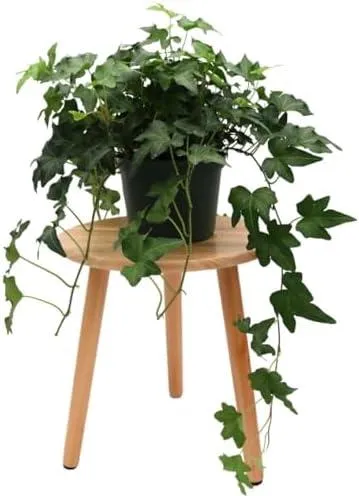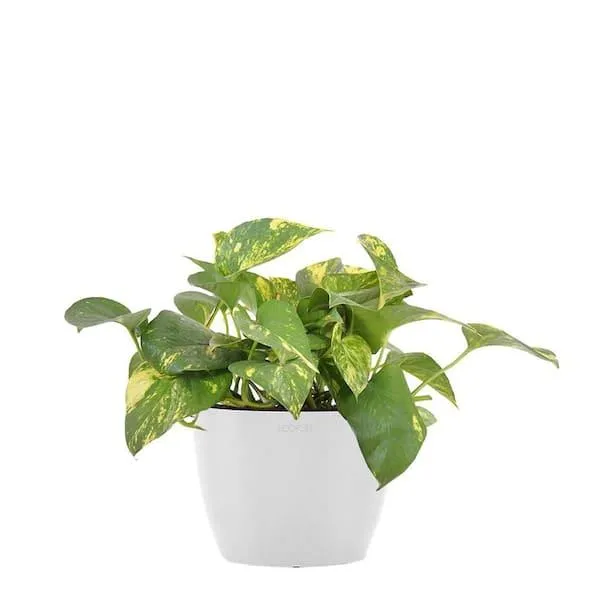Your Complete Guide to Growing Ivy Indoors
If you’re looking for easy-care, virtually indestructible houseplants, look no further than ivy. Various ivy species have been popular houseplants for decades due to their low maintenance needs and ability to thrive in different indoor conditions. In this article, I’ll answer common questions on ivy houseplants and provide tips for successful growth based on my years of experience as an avid gardener.
What Types of Ivy Are Best for Indoor Growing?
The three most common ivy varieties grown indoors are English ivy, Swedish ivy, and needlepoint ivy. All provide lush greenery with minimal effort:
- English ivy (Hedera helix) – The classic vining ivy with heart-shaped leaves. Very tolerant of low light. Will vine indefinitely if given support.
- Swedish ivy (Plectranthus verticillatus) – Thicker stems and dark green ovate leaves. Similar care needs as English ivy but more compact growth.
- Needlepoint ivy (Hedera helix ‘Needlepoint’) – Decorative trailing ivy valued for its small, dense leaves. Beautiful foliage but slower growing than other varieties.
All three species thrive in average indoor conditions and tend to be very forgiving of occasional neglect. Their trailing habits also make them perfect for desks, shelves, or hanging planters.
What Kind of Light Does Ivy Need?
Ivy is very tolerant of low light, which makes it suitable for indoor growing when sunlight may be limited. However, it will still benefit from as much light as possible. I’ve found the following general guidelines work well:
- English ivy does fine in medium to low light and can even survive in fairly shaded conditions indoors.
- Swedish ivy and needlepoint ivy prefer brighter indirect light for optimal growth but will adjust to lower light levels over time.
- For any ivy variety, a spot near an east- or west-facing window receives enough indirect sunlight throughout the day.
- South-facing windows provide the brightest conditions, though ivy may need to gradually adjust to full sun exposure at first.
With adequate lighting, ivy will remain bushy and full instead of becoming leggy and sparse-looking in search of more sun.
What Kind of Soil Do Ivy Plants Prefer?
Most indoor potting soils will work well for growing ivy as they are not fussy about soil composition. However, I’ve found that a well-draining potting mix specifically formulated for houseplants leads to healthier growth overall. The key aspects are:

- Good drainage is essential to prevent soggy, root-rot prone conditions. Add perlite or vermiculite to standard potting soil if needed.
- Ivy prefers soil that retains some moisture but dries out between waterings. This can be achieved by mixing potting soil with equal parts peat moss or coir fiber.
- Ivy is not super demanding nutritionally. Basic potting soils supplemented with timed-release fertilizer every few months will suffice.
Repot ivy annually into fresh soil to replenish nutrients and provide room for roots to expand. Just make sure the new container isn’t much bigger to avoid overwatering issues.
How Often Should You Water Ivy Plants?
Judging from experience, ivy’s watering needs vary seasonally based on temperature, humidity levels and light exposure in your home. As a general guideline:
- Water when the top inch or so of soil feels dry to the touch, usually every 7-10 days during spring/summer.
- Cut back watering frequency in winter when growth slows, allowing the soil to dry out partially between waterings.
- Mist foliage occasionally if indoor air is very dry to raise humidity around the plant.
- Avoid overwatering, as soggy soil causes root rot – this is the number one killer of indoor ivy!
An easy trick is bottom-watering the ivy – set the nursery pot inside a dish of water for 10 minutes, ensuring the soil absorbs moisture thoroughly from below.
How Should You Care for Climbing Ivy Vines?
English ivy and other climbing cultivars are true vines that will continue growing upwards indefinitely if provided support. Here are some tried-and-tested tips:
- Train vines onto bamboo stakes, picture frames or wooden trellises for atrailing effect.
- Use garden ties or twist ties to gently guide new growth where you want it to climb. Ivy can be shaped into walls, sculptures etc.
- Prune only to shape the plant or remove dead/damaged sections. Ivy responds well to occasional trimming.
- Provide sturdy anchors as the vines get heavy, especially for tall supports. Ivy can become top-heavy otherwise.
- Rotate the pot periodically so all sides get equal sunlight to discourage leggy growth on one side.
With the right care, ivy vines can trail beautifully for years indoors. Their versatility makes them a terrific indoor wall covering too!
Is Ivy Toxic to Pets or Children?
All parts of English ivy (Hedera helix) contain saponins, which can cause mild to moderate gastrointestinal upset if ingested in large amounts by pets or small kids. However, the potential for toxicity is relatively low compared to other common houseplants.

Most dogs and cats show little interest in eating ivy. Still, it’s best to baby-proof ivy displays and keep them out of reach of toddlers. Symptoms of possible poisoning include vomiting, diarrhea and fatigue. If concerned, contact your vet right away with a sample of the ingested plant material.
Overall, ivy poses a low risk indoors as long as curios children and animals aren’t actively encouraged to chew on it. With standard safety precautions, it can be safely grown around toddlers and pets.
Can Ivy Be Propagated from Cuttings?
Absolutely! Ivy is extremely easy to propagate from stem cuttings for an inexpensive way to get new plants. All it takes is a single node cutting with leaves:
- Use clean, sterile pruners to take 4-6″ sections of new leafy growth in spring or summer.
- Remove lower leaves, leaving the top set. Dip cut end in rooting hormone if desired.
- Stick cuttings 1-2″ deep in a loose potting mix. Water lightly and place in bright shade.
- Within 4-6 weeks, you’ll see roots forming. Pot up the baby plants and treat like a mature ivy.
This simple technique lets you multiply your ivy collection without cost. Give rooted cuttings as gifts too – they are sure to thrive!
Any Tips for Dealing with Ivy Pests or Diseases?
In general, ivy is very resistant to indoor pests and diseases. But here are a few potential issues:
- Mealybugs – cottony white bugs that suck plant sap. Wipe off with cotton balls dipped in rubbing alcohol.
- Spider mites – tiny red spiders on undersides of leaves. Spray with insecticidal soap or release predatory mites like Phytoseiulus persimilis.
- Powdery mildew – fluffy white coating. Cut back watering and increase air flow and sunshine exposure.
- Root rot from overwatering. Improve drainage and dry soil thoroughly between waterings.
Prune off severely damaged sections if needed. As preventive care, inspect new ivy purchases before bringing home. Basic hygiene like periodic leaf wiping and checkups will keep most problems at bay.

Wrapping Up
There’s a reason ivy has remained a popular houseplant for so long
Common Ivy Houseplants Care Guide
| Plant | Light Needs | Watering | Growth Rate | Notes |
|---|---|---|---|---|
| English Ivy | Partial sun to shade | Allow soil to dry between waterings | Vigorous vine | Tolerates low light; toxic to pets |
| Swedish Ivy | Bright indirect light | Water when top inch of soil is dry | Moderate | Hardier than English; variegated foliage |
| Peace Lily | Bright indirect light | Keep soil moist | Moderate | Flowers are white spathes;INDICATOR PLANT |
| Pothos | Low to bright indirect light | Allow soil to dry slightly between waterings | Vigorous vine | Tolerates neglect; toxoc to pets |
| Philodendron | Bright indirect light | Water when top inch of soil is dry | Moderate | Tolerates low light; heart-shaped leaves |
FAQ
-
What kinds of ivy grow best as houseplants?
English ivy and Swedish ivy, also called “needs” ivy, are basically the most popular ivy plants grown indoors. English ivy has smaller leaves and tolerates lower light. Swedish ivy has larger leaves and requires brighter light.
-
How do I care for an ivy houseplant?
Ivy houseplants need indirect sunlight and should be watered when the top of the soil feels dry. Feed them monthly in the spring and summer with a standard houseplant fertilizer. Trim away any leaves that start looking shabby. Though, be careful not to trim too much at once. They can handle lower light than some plants, but they’ll remain bushier with more sun.
-
Do ivies need pruning or trimming?
Occasionally, ivy plants may need a little maintenance. If the plant gets leggy or sparse looking, you can trim off the long strands and put the cuttings in water to propagate new plants. Possibly give the plant a light shearing every few months during active growth to keep it full. Pruning controls size and shape. On the other hand, an unpruned ivy will become long and lanky.
-
What are some signs that an ivy needs water?
Keep an eye out for drooping or wilted leaves. That could be a sign the ivy is thirsty. The soil should be allowed to dry out slightly between waterings. Another hint is lighter coloration in the leaves. When the plant looks dull or faded, it may need a drink. But be careful not to overwater – soggy soil can rot the roots. Ask yourself, “When was the last time I watered it?”
-
Will ivy climb or trail if given a support?
While ivy can be grown as a trailing plant, it has natural climbing tendencies. Providing a moss pole or letting it cascade over a shelf may inspire your ivy to climb or trail. The vines will attach themselves with tiny roots as they grow. English ivy is known to be a vigorous climber. Putting a pole or strings in the pot gives it something to grab onto. Otherwise, it’ll just grow outward in all directions.

-
What should I do if my ivy starts losing leaves?
If leaves start dropping, check whether the plant is getting too much or too little light, water, or fertilizer. Moving or adjusting care may solve the issue. Pests could also be the culprit – check closely for signs of bugs. As a last resort, repotting may be needed if the roots have become potbound. Losing some lower leaves is normal, but a lot of dropping top leaves may mean trouble. Monitor it and see what the plant is trying to tell you!
